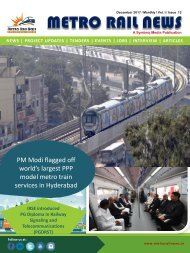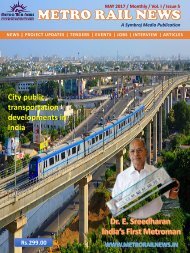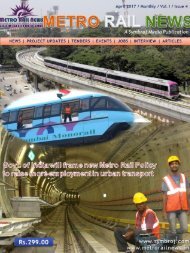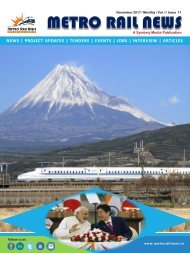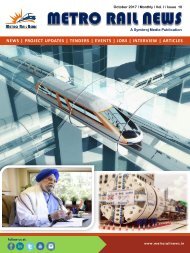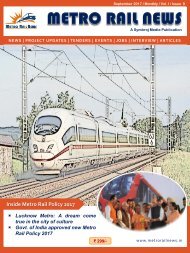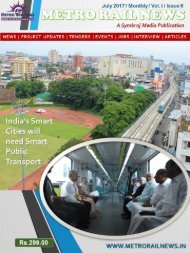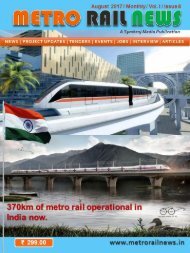Metro Rail News December 2016
You also want an ePaper? Increase the reach of your titles
YUMPU automatically turns print PDFs into web optimized ePapers that Google loves.
The world is increasingly an<br />
urban environment. Since 2008<br />
more than half of the world<br />
population lives in cities and<br />
the world population is<br />
expected to increase to roughly<br />
10 billion people over the next<br />
four decades. As the world’s<br />
rural population is projected to<br />
remain stable in this period,<br />
that increase will occur in<br />
urban areas. By 2050, 70% of all<br />
people will live in cities and<br />
the world urban population<br />
will have more than doubled<br />
compared to the turn of the<br />
century.<br />
In developing countries, where<br />
most of this uncontained<br />
population growth will take<br />
place, the rapidly expanding<br />
cities will need to meet the<br />
increased demands for<br />
infrastructure. Without<br />
efficient<br />
transport<br />
infrastructure, cities will<br />
sprawl away from the urban<br />
core, which strains the<br />
environment by creating more<br />
traffic congestion and travel<br />
time, loss of valuable farm<br />
land, and inequitable allocation<br />
of resources. In the developed<br />
countries the urban expansion<br />
is less rapid, but the<br />
demographics of the<br />
population will change, with<br />
an increasingly large group<br />
over 60. These population<br />
changes bring about new<br />
demands on the functions a<br />
city must provide and on the<br />
layout of the city, and call for<br />
continuous improvement in<br />
sustainable and resource<br />
efficient urban development.<br />
Although high urban density<br />
can help cities become more<br />
energy and resource efficient,<br />
urban density alone is not<br />
sufficient to obtain a high<br />
standard of living. Comparing<br />
the most densely populated<br />
cities with the most liveable<br />
ones shows there must be other<br />
factors involved. This paper<br />
proposes that an efficient and<br />
integrated use of the<br />
underground is one of these<br />
factors and gives a brief<br />
overview of the possible<br />
solutions the underground<br />
offers to improve the factors<br />
contributing to quality of live:<br />
safety, health, convenience,<br />
and comfort.<br />
An urban population that is<br />
increasingly aware of the<br />
factors that improve quality of<br />
living, poses increased<br />
demands on their environment<br />
with respect to: reliable and<br />
safe transport of people and<br />
goods; dependable utilities,<br />
water distribution and<br />
sewerage<br />
systems;<br />
sustainability of the<br />
environment and limited urban<br />
sprawl; green spaces and<br />
recreational areas; reduced<br />
energy use and reduced<br />
emissions and noise levels;<br />
aesthetics and conservation of<br />
heritages; efficient use of realestate<br />
and public space. In<br />
ARTICLES |<br />
existing urban areas these<br />
demands pose significant<br />
challenges, as the space needed<br />
for developing new functions<br />
or relocating and improving<br />
existing ones is often not<br />
readily available. Placement of<br />
infrastructure and other<br />
facilities underground presents<br />
an opportunity to find the<br />
needed space, but it is often<br />
considered only as a last resort.<br />
This stems from a paradox, as<br />
the underground is considered<br />
only when surface space is<br />
exhausted and no other<br />
solutions exist anymore for the<br />
complex urban problems to be<br />
tackled. This complexity and<br />
the obstructed access to the<br />
underground, created by the<br />
lack of space for the problem to<br />
be solved, almost inevitably<br />
lead to higher cost, giving<br />
underground solutions an<br />
expensive image, which in turn<br />
leads it to be considered less<br />
readily.<br />
In newly developing<br />
metropolises that paradox need<br />
not exist, as initially the access<br />
to the underground is not<br />
obstructed and unique<br />
opportunities exist, if<br />
engineers, city planners and<br />
decision makers can come<br />
together and recognize that in<br />
order to reach an optimal<br />
solution, the underground<br />
option needs to be considered<br />
and used from the start.<br />
<strong>Metro</strong> <strong>Rail</strong> <strong>News</strong> | <strong>December</strong> <strong>2016</strong> | www.metrorailnews.in 47






